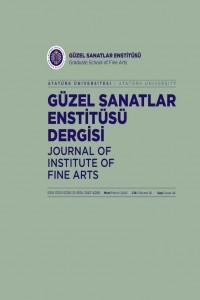Erzurum Ehram Dokuması Üzerine Deneysel Bir Çalışma
Ehram is a type of clothing used in outwear by women for covering or protection from cold. As a result of shearing the wool from sheep, cleaning it from its dirt, drying it by laying and spinning it, ehram yarns are prepared and woven on a wooden shuttle handloom. The colors of ehram consist of natural colors of sheep such as beige (coffee with milk in folk language), white, purple, and black. There are also many types of embroidery- ornament used in ehram weaving. These ornaments made to ehram during weaving such as walnut wing, basil branch, honeysuckle, double rice, antique, macaroni, the play of the star, lentil, lady's belly, rice grain, flying bird with head and without the head, fringe comb, double cards, diamond earrings, gazelle horn, merdin earrings. However, within the scope of the research, there are other motif applications such as "macaroni, and merdin earrings", which have not been found and have not been known in the literature but used by the local people.The study aims to bring a different perspective to the traditional usage of ehram in the light of the findings obtained by researching the ehram weaving in Erzurum. In this study, the applied research method was used. A model and pattern suggestions were developed over ehram woven to be used in the experimental designs of the research. 3 experimental clothing designs, which were prepared under the theme of sustainability, and the design card is presented to the reader with artistic drawing and pattern suggestions.
Anahtar Kelimeler:
Ehram, Erzurum, Motif, Deneysel Tasarım, Özgün Giysi Tasarımı, Original Clothing Design
An Experimental Study on Erzurum Ehram Weaving
Keywords:
Ehram, Erzurum, Ornament, Experimental Design,
___
- Başaran, F. N. (2014). Bayburt yöresinde geleneksel “Ehram dokumacılığı” üretim teknikleri, motif ve kompozisyon özellikleri. Milli Folklor, 26(104), 151-166. https://www.researchgate.net/profile/Fatma_ Basaran/publication/324115325
- Çelik, A. (1996). Erzurum’da kadın giyiminin tarihi süreci içinde ehram ve dokumacılığı. Atatürk Üniversitesi Güzel Sanatlar Enstitüsü Dergisi, 3, 1-26. https://dergipark.org.tr/tr/download/article-file/28524
- Çelik, A. (1997). Erzurum’da ehram (Tez No. 63339) [Yüksek Lisans Tezi, Atatürk Üniversitesi]. Yüksek Öğretim Kurulu Tez Merkezi.
- Çomaklı, Z. (2008). Anam başka bağlar bacım bir başka “Erzurum oyaları”. Aktif Yayınevi.
- Karahan, N., & Mangut, M. (2011). Tekstil lifleri. Ekin Yayınevi.
- Karasar, N. (2020). Bilimsel araştırma yöntemi. Nobel Akademik Yayıncılık.
- Kayserili, A. (2014). Erzurum şehrinin kültürel coğrafyası. Atatürk Üniversitesi Yayınları No: 1036.
- Kayserili, A. (2014). Erzurum’da ehram kullanımı [Fotoğraf]. Erzurum şehrinin kültürel coğrafyası. Atatürk Üniversitesi Yayınları No: 1036.
- Kayserili, A. (2014). Makarna motifi [Fotoğraf]. Erzurum şehrinin kültürel coğrafyası. Atatürk Üniversitesi Yayınları No: 1036.
- Kayserili, A. (2014). Merdin küpesi motifi [Fotoğraf]. Erzurum şehrinin kültürel coğrafyası. Atatürk Üniversitesi Yayınları No: 1036.
- Salman, F. (2004). Türk kumaş sanatında görülen geleneksel kumaş çeşitlerimiz. Sanat Dergisi, 0(6), 13-42. https://dergipark.org.tr/tr/download/article-file/28844
- Sari, S. (2017). Görsel kültür nesnesi olarak Erzurum arkeoloji müzesinde bulunan üç adet geleneksel giysi üzerine bir inceleme. Türkiye Sosyal Araştırmalar Dergisi, 21(3), 602-624. https://dergipark.org.tr/tr/download/article-file/385049
- Yaşaroğlu, H. (2018). Geçmişten günümüze ehram dokuma özellikleri ve özgün giysi tasarımları (Tez No. 528842) [Yüksek Lisans Tezi, Gazi Üniversitesi]. Yüksek Öğretim Kurulu Tez Merkezi.
- ISSN: 1300-9206
- Yayın Aralığı: Aylık
- Yayıncı: Atatürk Üniversitesi
Sayıdaki Diğer Makaleler
Thomas Hobbes’un İnsan Felsefesi Bağlamında The Platform (2019) Filmi Üzerine Bir Analiz
Mimari ve Plastik Sanat Akımlarının Gotik ve Rönesans Dönem Koro Müziğine Yansımaları
Sanal Gerçekliğin Reklam Stratejilerinde Kullanılmasına Yönelik Bir Değerlendirme
Elektrik ve Grafik Tasarım: Ameli Elektrik Dergisi Kapaklarının Görsel Analizi
Grafik Tasarımı Bölümü Öğrenme Çıktılarının 21. Yüzyıl Becerileri Temelinde İncelenmesi
Aytaç ÖZMUTLU, Emel BAYRAK ÖZMUTLU
Afrika Sanatının Koruyucu İşlevi Ekseninde Nick Cave’in Sanat Pratiği
Erzurum Ehram Dokuması Üzerine Deneysel Bir Çalışma
